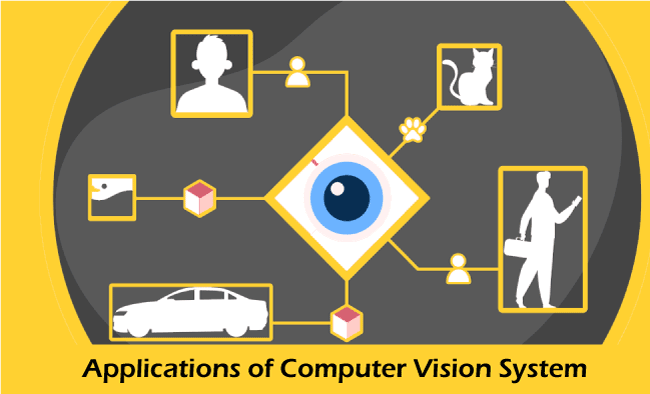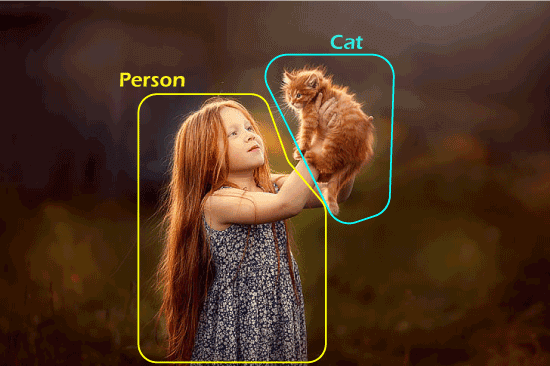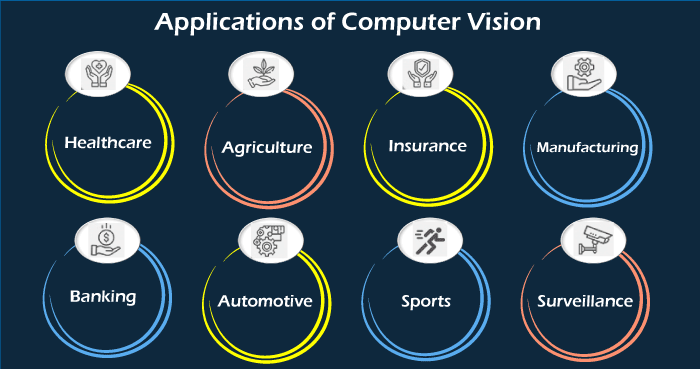Computer Vision Applications
Computer vision is a subfield of AI (Artificial Intelligence), which enables machines to derive some meaningful information from any image, video, or other visual input and perform the required action on that information. Computer vision is like eyes for an AI system, which means if AI enables the machine to think, computer vision enables the machines to see and observe the visual inputs. Computer vision technology is based on the concept of teaching computers to process an image or a visual input at pixels and derive meaningful information from it. Nowadays, Computer vision is in great demand and used in different areas, including robotics, manufacturing, healthcare, etc. In this topic, we will discuss some popular applications of Computer Vision, but before that, let's first understand some common tasks that are performed by computer vision.

Below are some common tasks for which computer vision can be used:
- Image Classification: Image classification is a computer vision technique used to classify an image, such as whether an image contains a dog, a person's face, or a banana. It means that with image classification, we can accurately predict the class of an object present in an image.
- Object Detection: Object detection uses image classification to identify and locate the objects in an image or video. With such detection and identification technique, the system can count objects in a given image or scene and determine their accurate location, along with their labelling. For example, in a given image, there is one person and one cat, which can be easily detected and classified using the object detection technique.

- Object Tracking: Object tracking is a computer vision technique used to follow a particular object or multiple items. Generally, object tracking has applications in videos and real-world interactions, where objects are firstly detected and then tracked to get observation. Object tracking is used in applications such as Autonomous vehicles, where apart from object classification and detection such as pedestrians, other vehicles, etc., tracking of real-time motion is also required to avoid accidents and follow the traffic rules.
- Semantic Segmentation: Image segmentation is not only about detecting the classes in an image as image classification. Instead, it classifies each pixel of an image to specify what objects it has. It tries to determine the role of each pixel in the image.
Computer Vision Applications
As per the increasing demand for AI and Machine Learning technologies, computer vision also has a great demand among different sectors. It has a massive impact on different industries, including retail, security, healthcare, automotive, agriculture, etc. Below are some most popular applications of computer vision:
- Defect detection using Computer Vision
- OCR using Computer vision
- Crop Monitoring
- Analysis of X-rays, MRI, and CT scans using Computer Vision
- Road Condition Monitoring
- 3D model Building using Computer vision
- Cancer Detection using Computer Vision
- Plant Disease Detection using Computer Vision
- Traffic Flow Analysis
Above are some most common applications of Computer vision. Now let us discuss applications of computer vision across different sectors such as Retail, healthcare, etc.

1. Computer Vision in Healthcare
The Healthcare industry is rapidly adopting new technologies and automation solutions, one of which is computer vision. In the healthcare industry, computer vision has the following applications:
- X-Ray Analysis
Computer vision can be successfully applied for medical X-ray imaging. Although most doctors still prefer manual analysis of X-ray images to diagnose and treat diseases, with computer vision, X-ray analysis can be automated with enhanced efficiency and accuracy. The state-of-art image recognition algorithm can be used to detect patterns in an X-ray image that are too subtle for the human eyes.
- Cancer Detection
Computer vision is being successfully applied for breast and skin cancer detection. With image recognition, doctors can identify anomalies by comparing cancerous and non-cancerous cells in images. With automated cancer detection, doctors can diagnose cancer faster from an MRI scan.
- CT Scan and MRI
Computer vision has now been greatly applied in CT scans and MRI analysis. AI with computer vision designs such a system that analyses the radiology images with a high level of accuracy, similar to a human doctor, and also reduces the time for disease detection, enhancing the chances of saving a patient's life. It also includes deep learning algorithms that enhance the resolution of MRI images and hence improve patient outcomes.
2. Computer Vision in Transportation
With the enhanced demand for the transportation sector, there has occurred various technological development in this industry, and one of such technologies is Computer vision. Below are some popular applications of computer vision in the transportation industry:
- Self-driving cars
Computer vision is widely used in self-driving cars. It is used to detect and classify objects (e.g., road signs or traffic lights), create 3D maps or motion estimation, and plays a key role in making autonomous vehicles a reality.
- Pedestrian detection
Computer vision has great application and research in Pedestrian detection due to its high impact on the designing of pedestrian systems in various smart cities. With the help of cameras, pedestrian detection automatically identifies and locate the pedestrians in image or video. Moreover, it also considers the variations among pedestrians related to attire, body position, and illuminance in different scenarios. This pedestrian detection is very helpful in different fields such as traffic management, autonomous driving, transit safety, etc.
- Road Condition Monitoring & Defect detection
Computer vision has also been applied for monitoring the road infrastructure condition by accessing the variations in concrete and tar. A computer vision-enabled system automatically senses pavement degradation, which successfully increases road maintenance allocation efficiency and decreases safety risks related to road accidents.
To perform road condition monitoring, CV algorithms collect the image data and then process it to create automatic crack detection and classification system.
3. Computer Vision in Manufacturing
In the manufacturing industry, the demand for automation is at its peak. Many tasks have already been automated, and other new technology innovations are in trend. For providing these automatic solutions, Computer vision is also widely used. Below are some most popular applications
- Defect Detection
This is perhaps, the most common application of computer vision. Until now, the detection of defects has been carried out by trained people in selected batches, and total production control is usually impossible. With computer vision, we can detect defects such as cracks in metals, paint defects, bad prints, etc., in sizes smaller than 0.05mm.
- Analyzing text and barcodes (OCR)
Nowadays, each product contains a barcode on its packaging, which can be analyzed or read with the help of the computer vision technique OCR. Optical character recognition or OCR helps us detect and extract printed or handwritten text from visual data such as images. Further, it enables us to extract text from documents like invoices, bills, articles, etc. and verifies against the databases.
- Fingerprint recognition and Biometrics
Computer vision technology is used to detect fingerprints and biometrics to validate a user's identity.
Biometrics is the measurement or analysis of physiological characteristics of a person that make a person unique such as Face, Finger Print, iris Patterns, etc. It makes use of computer vision along with knowledge of human physiology and behaviour.
- 3D Model building
3D model building or 3D modelling is a technique to generate a 3D digital representation of any object or surface using the software. Computer vision plays its role here also in constructing 3D computer models from existing objects. Furthermore, 3D modelling has a variety of applications in various places, such as Robotics, Autonomous driving, 3D tracking, 3D scene reconstruction, and AR/VR.
4. Computer Vision in Agriculture
In the agriculture sector, Machine Learning has made a great contribution with its models, including Computer vision. It can be used in areas such as crop monitoring, weather analysis, etc. Below are some popular cases of computer vision applications in Agriculture:
- Crop Monitoring
In the agriculture sector, crop and yield monitoring are the most important tasks for better agriculture. Traditionally, it depends on subjective human judgment, but that is not always accurate. With computer vision systems, real-time crop monitoring and identification of any crop variation due to any disease or deficiency of nutrition can be made.
- Automatic Weeding
An automatic weeding machine is an intelligent project enabled with AI and computer vision that removes unwanted plants or weeds around the crops. Traditionally weeding methods require human labour, which is costly and inefficient compared to automatic weeding systems.
Computer vision enables the intelligent detection and removal of weeds using robots, which reduces costs and ensures higher yields.
- Plant Disease Detection
Computer vision is also used in automated plant disease detection, which is important at an early stage of plant development. Various deep-learning-based algorithms use computer vision to identify plant diseases, estimate their severity and predict their impact on yields.
5. Computer Vision in Retail
In the retail sector, computer vision system enables retailers to collect a huge volume of visual data and hence design better customer experiences with the help of cameras installed in stores. Some popular applications of computer vision in the retail industry are given below:
- Self-checkout
Self-checkout enables the customers to complete their transactions from a retailer without the need for human staff, and this becomes possible with computer vision. Self-checkouts are now helping retailers in avoiding long queues and manage customers.
- Automatic replenishment
Automated stock replenishment is a leading technology innovation in retail sectors. Traditionally, stock replenishment is performed by store staff, who check selves to track the items for inventory management. But now, automatic replenishment with computer vision systems captures the image data and performs a complete inventory scan to track the shelves item at regular intervals.
- People Counting
Nowadays, various situations occur where we may need the count of people or customers entering and leaving the stores. This foot count or people counting can be done by computer vision systems that analyze the image or video data captured by the in-store cameras. People counting is helpful in managing the people and allowing the limited people for cases such as Covid social distancing.
|


 For Videos Join Our Youtube Channel: Join Now
For Videos Join Our Youtube Channel: Join Now











